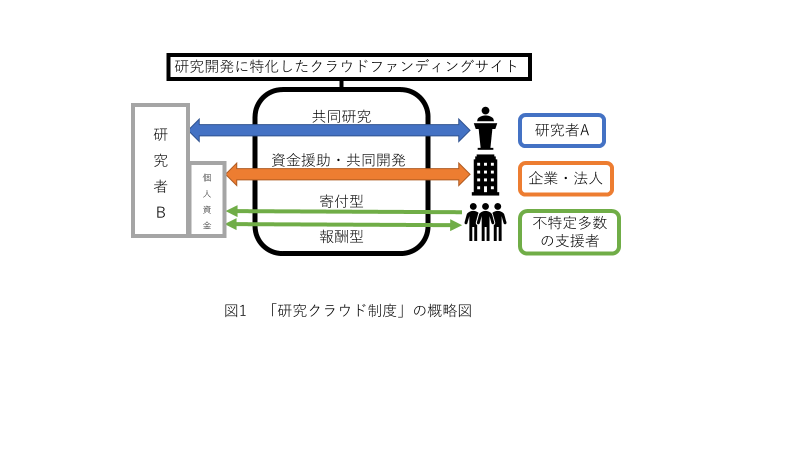- Index
- ①Economic Growth and Research & Development(R&D)
- ②The decrease of Japanese R&D level
- ③The Pos-doc problem and the distribution of research funds
- ④The joint research as the effective method.
- ⑤The summary of discussions and problems
- ⑥The research crowdfunding system.
- ⑦The significance and the problem in this system.
- ⑧Conclusion
- References
①Economic Growth and Research & Development(R&D)
R&D is the keystone of economic growth. From the start of the research by Solow(1959), R&D has the positive effect on economic productivity and growth(Mankiw, 1995; Morikawa, 2013). Some research related to economic growth found that the relationship between R&D and GDP is valid evidence(). The intrinsic economic growth theory reveals that R&D has more influences on economics than the finance and the investment.
On the other hand, much evidence showed that the human capital such as education fosters the economic growth(Lucus, 1988). But, even the increase of human capital does not directly contribute to the economic growth so much. Rather, constructing the R&D circumstances by the infrastructure maintenance enlarges the effect of the human capital(Hall and Jones, 1999; Kodama, 2002).
スポンサーリンク
②The decrease of Japanese R&D level
Some research suggests that the quality of japanese R&D becomes a remarkable decrease(Fuyuno, 2017).
In fact, R&D expenditure to GDP is higher than other OECD countries(OECD, 2018). Fuyuno(2017) pointed that the quantitative level of japanese R&D deteriorates because the number of the paper written by japanese researchers is lower than the past. Top 10% paper and Top 1% paper to the reference rate in japanese paper decrease. Moreover, as the number of references of japanese paper decreases, the qualitative level of japanese R&D has fallen(Fuyuno, 2017; MEXT, 2016).
Both the qualitative and quantitative decline of japanese R&D is sever. In this context, the decline of R&D expenditure at japanese policy get the level of R&D to be lower. It contradicts the japanese policy which fosters the new production and the innovation.
スポンサーリンク
③The Pos-doc problem and the distribution of research funds
1) The Pos-doc problem
The Ministry of Education, Culture, Sports, Science and Technology(MEXT)(2018) reported that 70% of PhD has no tenure and examines with the anxiety for their future. In the Nature published in 2017, the anxiety for people having PhD is not only in Japan, but also worldwide problem(Woolston, 2017). This problem is called "Pos-doc problem" in Japan.
MEXT(2018) indicates that the postdoctoral people always have the three years term. In addition, they get distress to their situation in which they cannot examine their-wishing investigations and conduct the innovative research while the government found the short-term performance more important. They are in the environment in which they cannot do the new and original research.
To solve this problem, many universities make a variety of actions. But, PhD people need the new environment and system in order to examine without the anxiety for their future.
2)The problem of the distribution of research funds
Japanese scientific performance is relatively low while the research expenditure to GDP is higher than other OECD countries. As one reason, the research funds is not effectively distributed to researchers. In 1969 paper, it was pointed that there were the deviation and the waste of the research funds in Japan(Tanigawa, 1969). In the report of MEXT(2014), the popular national universities got more funds than other universities. Importantly the research performance was not correlated with the funds price. Whereas researchers got the much funds, they are busy in writing reports and did not have times to conduct their research(MEXT, 2014).
In fact, not only those who do not have so much research funds, but also researchers who get them generally spend less time to make a study(文科省, 2016). The reason why the correlation is not so strong in Japan is the inefficient use of research expenses.
The distribution of them to the national universities other than the popular national universities is markedly limited. A small number of funds have bad effects on the education in the former universities(MEXT, 2014).
The system is required that gets rid of the deviation of research funds and in that researchers spend enough time to conduct their research. In such the new system as redistributing the research funds or encouraging the joint research, researchers can share their excess expenses on other researchers who do not have them so much.
スポンサーリンク
④The joint research as the effective method.
The number of joint research is less in Japan than in other countries(MEXT, 2016). Becker & Dietz(2004) showed that the joint research tended to have great quality and interact with other areas to product new research. Moreover, the joint research has great academic impact and could be the origin of discoveries associated with the innovation and the economic growth(Becker & Dietz, 2004).
The distribution of much research funds to the pos-doc and hopeful young researchers by carrying out the joint research is more effective and actual way than just by redistributing all research funds. In the joint research, researchers could share their tasks of writing reports on other researchers. Therefore, the joint research helps funders to decrease their burdens and spend more time to conduct researches.
スポンサーリンク
⑤The summary of discussions and problems
1) Japanese government should promote R&D in order to accomplish the economic growth and the innovation. But, the Japanese R&D expenditure is presently the decreasing trend.
2) Recently, Japanese research becomes lower both in the qualitative and quantitative level. The short-term research increases. There is no effective solution to them.
3) As the pos-doc problem, the high human capital like people having Phd is not effectively used in Japan. They conduct research with anxiety. We need the system that activates the joint research and in that they can focus on the research.
4) The problem is that Japan has lower research outcome than other countries while the japanese R&D expenditure to GDP is higher. The deviation of research funds and the less time to conduct research are the main reason to the problem.
5) Above, researchers cannot focus on their research. Therefore, it is difficult for them to challenge the new and innovative research.
Taken these discussion for granted, we make the system in which the following three points are satisfied: the system which fosters the joint research to improve the research situation in Japan, which solve the deviation of research funds as the type of the joint research, and in which researchers can focus on the investigation without the anxiety for the future.
I suggest the research crowdfunding system that is satisfied with above three points.
スポンサーリンク
⑥The research crowdfunding system.
1) General Figure
In this chapter, I suggest the system which adopts the crowdfunding into the academic R&D. The purpose of this system is to promote the joint research, to help researchers to individually gain the expenses for their research, and to extend the research network. When these are accomplished, I think to solve the problems in the chapter 5.
Mollick (2014)defined the crowdfunding as “the efforts by entrepreneurial individuals and groups -cultural, social, and for-profit- to fund their ventures by drawing on relatively small contributions from a relatively large number of individuals using internet, without standard financial intermediaries”. In the research crowdfunding system, “entrepreneurial individuals and groups” in this definition are replaced with the researcher. Researchers are added as the funder.
I define the research crowdfunding system as above. In figure 1, I show the general figure of this system. In Japan, there is one academic crowdfunding called "Academist"(Shitou, 2015).

I explain the system along the figure 1. In this system, there are three type funders. First is the researcher, who can share their research funds on other researchers in order to help the receiver to conduct his/her research or to support him/her as the joint research. Second is the company or the corporation, which conduct the joint research with researchers. Third is the private supporters, who can bring their own money to the researchers just like as the crowdfunding.
2) Method
This system begins by putting in their research plan and their name on this crowdfunding site. In order to receive the money, researchers can choose the way of the reception. First is the joint research - only researchers can use . The second is the private reception - this is used by the company, the corporation, and the ordinary people. If the researcher A becomes interested in the research plan written by researcher B, A comes to contact with B through this website. When the joint research is realized through the discussion with A and B, A can share the research funds on B instead of the money in the B private reception. If the money in the private reception satisfies the set goal by B before the joint research comes into reality, however, B can use the money in the private reception to conduct the research.
In private reception, there is two types of the reception: the donation type and the reward type. In both type, the researcher need not to turn the money. But, the researcher cannot use it as private money. The researcher can basically use the extra-money to assign other research or the joint research. He/She can turn their extra-money to the giver on the basis of the price rate.
The above system is common with two types. But, in the reward type, the researcher must give his/her research outcome report or product to the funder as the reward.
A flow of this research crowdfunding system is as followed: 1) putting in their research plan on the website. 2) waiting for the joint research or for reaching the set goal price. 3) conducting their research along their plan. ((4) report the outcome). It is three steps except that the funder chooses the reward type. Out of the joint research, researchers must not write the result reports so that they can focus on the study. The joint research can give the researcher to get the opportunity to study who could not gain research funds. Researchers use the private reception to conduct challenging and innovative research. They can do it without the anxiety for the failure to study.
Above is the basis of the research crowdfunding system This system takes over the crowdfunding. It can solve the three problems.
スポンサーリンク
⑦The significance and the problem in this system.
1) Significance
First, this system promotes the joint research. Integrating different research areas can produce the new and innovative research. It improves the japanese research quality.
Second, the joint research solves the deviation of research funds and redistributes them in the popular national universities to other universities. This helps researchers to study and cut the time to write the research reports. Moreover, this system let researcher study as the joint research who could not get research funds. It results that the japanese research quality and quantity improve, and that researchers use the funds effectively.
Third, this system can be the way to solve the pos-doc problem. Even if the researcher does not get tenure, they can gain the money for their research through this system. It is important for the researchers to study except public research expenses. This system gets their anxiety to be lower. They can produce sufficient research results without public research funds. It is more possible for them to get tenure. This system can not solve the pos-doc problem fundamentally, but this system helps their anxiety to be settled.
Fourth, researchers can challenge the new research. There are many researchers who do not conduct their-whishing research with less funds. However, this system is the R&D specific crowdfunding in which they have no obligation to return the money or outcome. They can use the money to conduct their wishing and innovative research. In the results, this system fosters to produce the new goods and the innovation.
Fifth, this system builds the network of researchers. They do not know other's research except their research area. They come to know other research only at the association or the symposium. They can use this system to know each other. This makes the research communities. Activating the interaction with researchers cultivate new research areas.
2)The Problems
There are problems in this system while this is effective. Zeisho(2016) pointed to the problem of the crowdfunding. This system has the same problems as the crowdfunding.
First is the problem of the information security. Zeisho(2016) claimed the problems of linking the research plan and the private information. The research outcome and plan can be stolen by other researchers in this system. However, it matters in the current public research system. This problem is not important because 日本学術振興会 opens the research plan and the outcomes. When the researchers write the date on the website of this system, they can deal with this problem even if their research plan and outcomes are stolen.
Second is the problem of whether researchers accomplish their research after they got the money in this system. It is not so important from below two reasons. The first reason is the research priority. The researchers conduct their research as soon as they can. This is also the same as R&D. The second reason is the researcher's motivation. As pointed in the significance of this system, those who use this system want to conduct innovative and challenging researches. This encourages them to study. From these two reasons, the researcher makes it sooner. If they do not do it,their reputation deteriorates because of writing their name. In practice, Shitou(2016) reported the success of the crowdfunding specific to R&D. Instead of the possibility of the failure to study, it is impossible to stop doing it.
スポンサーリンク
⑧Conclusion
In this paper, I suggest the research crowdfunding system. Although the quality and quantity of japanese researches deteriorates, this system can contribute to the improvement of japanese R&D. This is the keystone to solve the pos-doc problem and the deviation of research funds. Introducing this system activates the joint research and japanese researchers themselves. It can be associated with the innovation and japanese economic growth.
スポンサーリンク
References
Barro Robert J. and Sala-i-Martin Xavier, 1995, Technological Diffusion, Convergence, and Growth, NBER Working Paper No. 5151.
Becker Wolfgang, and Dietz Juergen, 2004, R&D cooperation and innovation activities of firms—evidence for the German manufacturing industry., Research Policy, Vol. 33, 2, 209-223.
Fuyuno Ichiko, 2017, What price will science pay for austerity?, Nature, 543, S10–S15.
King David A., 2004, The scientific impact of nations., Nature, 430, 311-316.
Hall Robert E. and Jones Charles I., 1999, Why Do Some Countries Produce So Much More Output Per Worker Than Others?, The Quarterly Journal of Economics, Vol. 114, No. 1, 83-116.
MEXT(2016)科学技術・学術政策研究所, 2016, NISTEPブックレット-1(ver. 3) 日本の科学研究力の現状と課題.
MEXT(2018)科学技術・学術政策研究所, 2018, 「博士人材追跡調査」第 2 次報告書, NISTEP REPORT No. 174.
MEXT(2014)科学技術振興機構研究開発戦略センター, 2014, (調査報告書)中間報告書 我が国の研究費制度に関する基礎的・俯瞰的検討に向けて ~論点整理と中間報告~, CRDS-FY2014-RR-03.
Kim and Ito, 2013, R&D Investment and Productivity: A comparative study of Japanese and Korean firms., RIETI Discussion Paper Series, 13-E-043.
Kodama(2000)児玉, 2000, 経済成長の促進要因, 経済論集, 25(2), 41-56.
Mankiw NG., 1995, The Growth of Nations. Brookings Papers on Economic Activity. 1, 275-326.
Mollick Ethan, 2014, The dynamics of crowdfunding: an exploratory study., Journal of Business Venturing, 29, 1-16.
Morikawa(2013)森川, 2013, RIETIの生産性研究について:アップデート, RIETI Policy Discussion Paper Series, 13-P-010.
OECD, 2018, Gross domestic spending on R&D., https://data.oecd.org/rd/gross-domestic-spending-on-r-d.htm#indicator-chart.
Schwienbacher Armin. and Larralde Benjamin., 2010, Crowdfunding of small entrepreneurial ventures., SSRN Electronic Journal.
Solow Robert N., 1959, A Contribution to the Theory of Economic Growth., The Quarterly Journal of Economics, Vol. 70, No. 1, 65-94.
Shitou(2015)柴藤, 2015, 学術系クラウドファンディング・プラットフォーム「academist」の挑戦, 経営管理, Vol. 57, 10, 709-715.
朱, 2016, 人的資本、研究開発と経済成長における実証分析―中国と東アジアの経済成長を中心に―, 経済科学研究, 20(1), 105-118.
Tanigawa(1969)谷川, 1969, 科学研究費に関するある問題点(放談室), 素粒子論研究, 39(1), 63-66.
Woolston Chris, 2017, Graduate survey: A love–hurt relationship., Nature, 550, 549–552
Zeisho(2016)税所, 2016, ICTを活用した新しいビジネスモデルに関する一考察 : クラウドソーシングの実態と課題 (遠山曉教授 古稀記念論文集), 商学論纂, 57(5・6), 111-157.
スポンサーリンク


